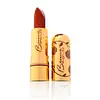What's inside
What's inside
 Key Ingredients
Key Ingredients

 Benefits
Benefits

 Concerns
Concerns

 Ingredients Side-by-side
Ingredients Side-by-side

Hydrogenated Polyisobutene
EmollientOctyldodecanol
EmollientKaolin
AbrasiveCaprylic/Capric Triglyceride
MaskingIsopropyl Lanolate
EmollientEuphorbia Cerifera Wax
Ozokerite
Emulsion StabilisingRicinus Communis Seed Oil
MaskingMica
Cosmetic ColorantBis-Diglyceryl Polyacyladipate-2
EmollientMicrocrystalline Wax
Emulsion StabilisingAluminum Starch Octenylsuccinate
AbsorbentCetyl Alcohol
EmollientCopernicia Cerifera Wax
Phenoxyethanol
PreservativeBHT
AntioxidantPentaerythrityl Tetra-Di-T-Butyl Hydroxyhydrocinnamate
AntioxidantTitanium Dioxide
Cosmetic ColorantIron Oxides
CI 15850
Cosmetic ColorantCI 19140
Cosmetic ColorantCI 45380
Cosmetic ColorantBlue 1 Lake
Cosmetic ColorantHydrogenated Polyisobutene, Octyldodecanol, Kaolin, Caprylic/Capric Triglyceride, Isopropyl Lanolate, Euphorbia Cerifera Wax, Ozokerite, Ricinus Communis Seed Oil, Mica, Bis-Diglyceryl Polyacyladipate-2, Microcrystalline Wax, Aluminum Starch Octenylsuccinate, Cetyl Alcohol, Copernicia Cerifera Wax, Phenoxyethanol, BHT, Pentaerythrityl Tetra-Di-T-Butyl Hydroxyhydrocinnamate, Titanium Dioxide, Iron Oxides, CI 15850, CI 19140, CI 45380, Blue 1 Lake
Caprylic/Capric Triglyceride
MaskingTrioctyldodecyl Citrate
EmollientOzokerite
Emulsion StabilisingOctyldodecanol
EmollientKaolin
AbrasiveSqualane
EmollientMicrocrystalline Wax
Emulsion StabilisingBeeswax
Emulsion StabilisingBis-Diglyceryl Polyacyladipate-2
EmollientCetyl Palmitate
EmollientDiisostearyl Malate
EmollientCopernicia Cerifera Wax
Euphorbia Cerifera Wax
Trihydroxystearin
Skin ConditioningMica
Cosmetic ColorantPhenoxyethanol
PreservativeVanillin
MaskingTocopheryl Acetate
AntioxidantEthylhexylglycerin
Skin ConditioningIron Oxides
Caprylic/Capric Triglyceride, Trioctyldodecyl Citrate, Ozokerite, Octyldodecanol, Kaolin, Squalane, Microcrystalline Wax, Beeswax, Bis-Diglyceryl Polyacyladipate-2, Cetyl Palmitate, Diisostearyl Malate, Copernicia Cerifera Wax, Euphorbia Cerifera Wax, Trihydroxystearin, Mica, Phenoxyethanol, Vanillin, Tocopheryl Acetate, Ethylhexylglycerin, Iron Oxides
 Reviews
Reviews

Ingredients Explained
These ingredients are found in both products.
Ingredients higher up in an ingredient list are typically present in a larger amount.
This ingredient is lipid-based synthetic skin-conditioning agent derived from adipic acid and a mixture of fatty acids. It is often called a lanolin substitute.
As an emollient, it helps soften and hydrate the skin. Emollients create a barrier on the skin to trap moisture in.
Due to its fatty acid base, it may not be Malassezia folliculitis safe.
Learn more about Bis-Diglyceryl Polyacyladipate-2This ingredient is an emollient, solvent, and texture enhancer. It is considered a skin-softener by helping the skin prevent moisture loss.
It helps thicken a product's formula and makes it easier to spread by dissolving clumping compounds.
Caprylic Triglyceride is made by combining glycerin with coconut oil, forming a clear liquid.
While there is an assumption Caprylic Triglyceride can clog pores due to it being derived from coconut oil, there is no research supporting this.
Learn more about Caprylic/Capric TriglycerideCopernicia Cerifera Wax comes from a palm tree native to Brazil; another name for this ingredient is Carnauba Wax.
This ingredient is used to thicken texture and also leaves behind a film when applied.
Fun fact: This wax has the highest melting point of all natural waxes and low solubility.
Learn more about Copernicia Cerifera WaxKaolin is a clay. It is used for oil control and to help minimize pores. Like other clays, kaolin has the ability to absorb excess sebum or oil. This can help clean out pores and mattify the skin.
Some types of kaolin may have exfoliating properties. When water is added to kaolin, it becomes a paste with small abrasive particles.
Most kaolin is a white color, but may be pink/orange/red depending on where it comes from.
The name 'kaolin' comes from a Chinese village named 'Gaoling'. Kaolin clay comes from rocks rich in kaolinite. Kaolinite, the mineral, has a silicate layered structure. Kaolinite is formed from chemical weathering of aluminum siilicate minerals.
Besides skincare, kaolin is commonly used to make glossy paper, in ceramics, toothpaste, and as medicine to soothe stomach issues.
Learn more about KaolinMica is a naturally occurring mineral used to add shimmer and color in cosmetics. It can also help improve the texture of a product or give it an opaque, white/silver color.
Serecite is the name for very fine but ragged grains of mica.
This ingredient is often coated with metal oxides like titanium dioxide. Trace amounts of heavy metals may be found in mica, but these metals are not harmful in our personal products.
Mica has been used since prehistoric times throughout the world. Ancient Egyptian, Indian, Greek, Roman, Aztec, and Chinese civilizations have used mica.
Learn more about MicaMicrocrystalline Wax is created by de-oiling petroleum. It is highly refined and purified before being added to cosmetics.
Microcrystalline Wax is used to enhance the texture and create even consistency. It helps stabilize a product by preventing ingredients from separating.
Octyldodecanol is a fatty alcohol. It is primarily used to enhance the texture of products.
As an emulsifier, Octyldodecanol helps prevent the oils and waters from separating. It also prevents ingredients from creating foam when shaken.
Octyldodecanol is created by reducing fatty acid to an alcohol.
Due to its high molecular weight, it does not get absorbed into the skin.
Learn more about OctyldodecanolOzokerite is a naturally occuring mineral wax. In cosmetics, ozokerite is used as a texture enhancer.
Ceresin wax is derived from this ingredient.
The melting point of ozokerite is 58-100 C.
Ozokerite is found all over the world including Scotland, the US, and India.
Learn more about OzokeritePhenoxyethanol is a preservative that has germicide, antimicrobial, and aromatic properties. Studies show that phenoxyethanol can prevent microbial growth. By itself, it has a scent that is similar to that of a rose.
It's often used in formulations along with Caprylyl Glycol to preserve the shelf life of products.
Euphorbia Cerifera wax comes from a shrub in Northern Mexico. It is used to stabilize formulations and has emollient properties.
Emollients form a thin layer on top of skin to prevent water from evaporating, keeping skin and lips hydrated.
According to a manufacturer, this wax can range from a yellow/brown color to translucent.
Learn more about Euphorbia Cerifera WaxThis ingredient is a combination of red, black, and yellow iron oxide pigments. This combination of colors is usually found in foundation, because it results in a "skin" color.